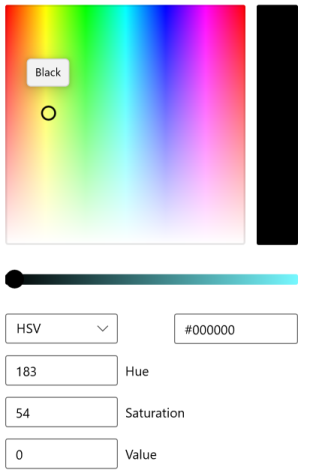
Private Sub ShowColorConverter(ByVal e As PaintEventArgs)ĭim m圜olor As Color = Color.PaleVioletRedĭim converter As = _ String colorAsString = converter.ConvertToString(Color.PaleVioletRed) Į.Graphics.DrawString(colorAsString, this.Font,

Private void ShowColorConverter(PaintEventArgs e) String^ colorAsString = converter->ConvertToString( Color::PaleVioletRed ) Į->Graphics->DrawString( colorAsString, this->Font, Brushes::PaleVioletRed, 50.0F, 50.0F ) System::ComponentModel::TypeConverter^ converter = System::ComponentModel::TypeDescriptor::GetConverter( m圜olor ) void ShowColorConverter( PaintEventArgs^ e )
#WPF COLORCONVERTER CODE#
Paste this code into a form and call the ShowColorConverter method when handling the form's Paint event, passing e as PaintEventArgs.
#WPF COLORCONVERTER WINDOWS#
This example is designed to be used with Windows Forms.
#WPF COLORCONVERTER HOW TO#
The following code example demonstrates how to use the ConvertToString method. If (ColorClassList.Count > index & .WebControls.WebColorConverter Examples Public void EditColorItem(int index,string hexString, string nameString) If(ColorClassList.Count > index || ColorClassList.Count=0)ĬolorClassList.Insert(0, new ColorClass(NextID, hexString, nameString)) Public void AddColorItem(int index,string hexString, string nameString) Return ColorClassList.Count > 0 ? ColorClassList.ID + 1 : 0 įile.WriteAllText(colorsFilePath, JsonConvert.SerializeObject(ColorClassList)) =JsonConvert.DeserializeObject>(File.ReadAllText(colorsFilePath)) Private readonly ColorListModel model = new ColorListModel() Namespace MVVM_Color_Utilities.ColorsList_TabĬlass ColorListViewModel : ObservableObject, IPageViewModel Namespace MVVM_Color_ClassesĬolorList_Tab ViewModel: using (Sets the icon for each viewmodel for display in the main window): using MaterialDesignThemes.Wpf Private void ChangeViewModel(IPageViewModel viewModel) OnPropert圜hanged("CurrentPageViewModel")

Public IPageViewModel CurrentPageViewModel PageViewModels.Add(new ImageQuantizer_Tab.ImageQuantizerViewModel()) ĬurrentPageViewModel = PageViewModels PageViewModels.Add(new ColorsList_Tab.ColorListViewModel()) Private IPageViewModel _currentPageViewModel Public class MainWindowViewModel : ObservableObject Should ColorClass use try and catch to create the brush or should an if else statement be used with a regex check on the hex code? Have I correctly placed the AddColorItem, EditColorItem and DeleteColorItem methods in the Model? Is MainWindowViewModel a good way of implementing navigation in MVVM?Ĭurrently my is unused however I've seen examples where it is used to bind the viewmodel, which should I use? SampleColorCommand sets the InputHexString to the color of cursor on screen.īesides general critique and corrections, I was hoping a few of my questions could be addressed: Edit and delete will perform the function upon the currently selected item in the Color List, with every change being saved to a text file in Json form. The execute command then executes the selected mode. Two textboxes are used to input the color name and hex, add and edit mode can be switched between by clicking on the AddSwitchCommand and EditSwitchCommand buttons.


This tab will then be represented by its Icon property from inheriting from IPageViewModel.ĬolorList_Tab supports adding, editing, deleting and saving colors to a text file in a Json format. By hashing together various online tutorials I've constructed my first MVVM application that lets users navigate between "tabs" and a "tab" (ColorList_Tab) that performs basic list functions such as adding, editing, deleting and saving colors.Ī new tab can be addded by adding a new data context to the MainWindow resources and then adding the viewmodel to PageViewModels list in the MainWindowViewModel.


 0 kommentar(er)
0 kommentar(er)
